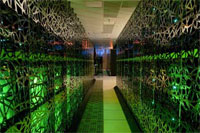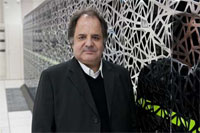The Dark Energy Universe Simulation -DEUS - project
The whole cosmos : from the idea to the equations. For the last two months, six scientists from the “Laboratoire Univers et Théorie » - LUTH1 - from the Observatoire de Paris have been trying hard to recreate the history and structure of the whole visible universe using the most powerful supercomputer currently available in France: the Curie machine of the civil society GENCI (“Grand équipement de calcul intensif”, consists of 92 000 processors calculates at the rate of up to 2 million billion operations per second (2 petaflops). It is being commissioned at the « Très grand centre de calcul TGCC » (the Very Large Computer Centre) of the CEA, a Bruyères-le-Châtel (Essonne).
Two cosmological models that include dark energy and dark matter have been tested so far. A third will follow this summer. This constitutes a major contribution to the application of massive parallel computing to solve new cosmological questions and to respond to important scientific challenges.
For this work, the team has been awarded the Joseph Fourier prize, named after the French mathematician and physicist. The reward, financed by the computer specialist Bull and the civil society GENCI, will be handed over at the École polytechnique, during a forum on high performance computing - Teratec.
Furthermore, Jean-Michel Alimi, initiator and leader of this work, will present it in the name of the collaboration, on July 12th 2012, to Geneviève Fioraso, minister for research and higher education, during the inauguration ceremony of the supercomputer Curie, at Bruyères-le-Châtel.
Another simulation, concerning the molecule involved in Alzheimer’s disease, will also be presented at this ceremony by chemists and quantum physicists from the University of Toulouse.
1 The Laboratoire Univers et Théorie LUTH is a scientific department of the Observatoire de Paris. It is associated with the CNRS and the Paris Diderot University.
Videos
In the midst of the history of matter, space and dark energy
And still many more images created by numerical simulation...
The history of the Universe is simulated in these animations. They were made by editing the simulations and show the evolution of a part of the Universe (cube or cone) since the Big Bang. The matter of the initially homogeneous primordial soup condenses into filaments, super clusters and clusters of galaxies. The final result depends to some extent on the initial relative values of various parameters and ingredients (dark energy, dark matter, vacuum energy). The detailed results of the calculation, notably the number and size of the largest existing clusters of matter, cannot at present be compared to observation. That will become possible only after ESA’s Euclid mission, to be launched in 2019, is in operation.
To find these images, follow the DEUS links on:
In the media
- New Scientist
- France Info
Du côté des étoiles - L’évolution de tout l’Univers, du big bang à nos jours, calculée par DEUS - Le Monde
- Ciel & Espace : article to appear in the July 2012 issue.


